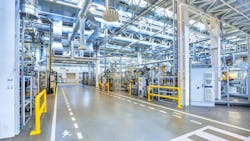Survey: Manufacturers mostly see competitive advantage of AI, but adoption is uneven
What you’ll learn:
- 93% said America’s industrial advantage will be built on intelligent manufacturing systems.
- 73% said companies that don’t embrace industrial realignment will be irrelevant within the next decade.
- 92% said advanced automation technologies make onshoring more viable.
When a new PricewaterhouseCoopers report talks about AI, it mentions that artificial intelligence technology is “no longer an experiment in manufacturing, it is becoming the backbone of industrial competitiveness.”
See also: ‘Digital retrofitting’ offers course through Industry 4.0 to Industry 5.0
And that assertion is backed up by the more than 500 executives who responded to the survey behind the report, 81% of whom plan to increase AI investments in the next three years.
And 93% say in the new PwC report, which was released Sept. 17, that America’s industrial advantage will be built on intelligent manufacturing systems. What’s more, 73% of those leaders said companies that don’t embrace industrial realignment will be irrelevant within the next decade.
Overall, the new data from PwC shows that 93% of executives surveyed said they believe the world is on the brink of the next industrial revolution.
73% of the executives said companies that don’t embrace industrial realignment will be irrelevant within the next decade.
- Supply chains and production will come closer to America. In the PwC survey, 19% of respondents said they are pursuing reshoring and 22% nearshoring to strengthen supply chain resiliency in the Trump tariff economy. And 90% of the executives surveyed believe companies that rely on distant suppliers in 2030 “will be extinct by 2035.”
- AI will reshape the workforce as well. In the survey, the industrial and energy execs said they are not bracing for AI to take human jobs away but instead are preparing to use the tech to make jobs better. Only 6% said they expect a future with limited AI use, for specialized tasks only. The rest are building toward a workplace where most roles are AI-augmented, and 9 in 10 said AI is prompting a “fundamental rethink of job roles in their sector.”
- Factories and supply chains are becoming modular and “self-aware.” Half of those surveyed said they’re investing in flexible product line reconfiguration, 52% in standardized production modules. By 2030, 49% of the industrials and energy execs said they expect their lines to be fully modular, up from just 6% that consider theirs fully modular today.
- Energy is a strategic asset and a competitive edge. Only 38% of leaders surveyed believe their current energy infrastructure can meet evolving needs over the next five years. So, 80% said they plan to increase investment in energy resilience within three years.
- Intelligent and automated systems are the future. 81% of leaders plan to increase investment in robotics. “Working alongside robots that are safer, smarter and more affordable than ever, the modern industrial worker will be skilled, AI-native and internationally competitive,” the PwC report notes.
Deeper into the findings: AI’s growth, so far, is uneven
The story for AI adoption has been tilted toward high-growth companies, according to the survey. Such companies are between eight and 17 percentage points more likely than peers to prioritize these investments, according to the PwC report. For them, the report notes, intelligent systems are not optional—they are the foundation of future industrial advantage.
Podcast: How manufacturing has evolved in 25 years
The report recommends industrials focus AI investment and deployment on high-value use cases, which it identifies as predictive maintenance, quality improvements and asset optimization, and scheduling.
Deeper into the findings: Resilient supply chains a matter of economic survival
Automation has lowered the cost of reshoring, tariffs may be driving it, and U.S. tax policy is incentivizing it, according to the survey, an assertion with which executives overwhelmingly agree: 92% said that advanced automation technologies make onshoring more viable. Nearly a third (32%) said they are pursuing strategic or aggressive reshoring now.
See also: The $2 trillion AI revolution: How smart factories are rewriting the rules
More than a third of the surveyed companies (34%) said they expect a majority (51% or more) of production to be reshored or nearshored by 2030. To meet this challenge, companies will need to address high capital costs and lead times for regionalizing production as well as talent shortages in key U.S. industrial hubs, according to the report.
Deeper into the findings: Energy infrastructure is a glaring liability
Only 38% of leaders surveyed believe their current energy infrastructure can meet evolving needs by 2030. But 80% nevertheless told PwC that they plan to increase investment in energy resilience within three years.
81% of leaders plan to increase investment in robotics.
See also: Sensing a shift: Trends in smart industrial automation
The report notes: “In the near term, gas will be key, and nuclear power will grow in importance as the promise of small, nuclear reactors is realized. Eventually, hydrogen, biofuels and synthetic compounds may power the future, as climate change continues to spur technological innovation to lower carbon emissions.
“Batteries and other storage technologies could offer compelling solutions to the intermittent availability of wind and solar power, allowing energy providers to better match supply and demand. But the timeline for green energy is longer, and the U.S. is in an energy race. Growing capacity is a competitive advantage.”
Deeper into the findings: On production modules
The report notes that capital priorities are being reshaped, with industrials and energy leaders “investing in plug-and-play agility,” as 52% in the PwC survey said their companies are focusing on “flexible production line reconfiguration that adapts to changing products and demand patterns.”
Another 46%, the report notes, are backing standardized production modules that use interchangeable equipment components.
“These design strategies are enabling faster, more responsive manufacturing environments that can scale or pivot as needed,” according to the report.
See also: Desktop Metal back from bankruptcy, former parent company restructures
The executives said in significant numbers that they are also are backing “self-healing” supply chains: systems that automatically detect, diagnose and correct disruptions. They’re investing in predictive equipment maintenance (43%), intelligent workforce reallocation (38%), adaptive production scheduling powered by AI (33%), and digital twin simulation and correction (30%).
About the Author
Scott Achelpohl
Head of Content
I've come to Smart Industry after stints in business-to-business journalism covering U.S. trucking and transportation for FleetOwner, a sister website and magazine of SI’s at Endeavor Business Media, and branches of the U.S. military for Navy League of the United States. I'm a graduate of the University of Kansas and the William Allen White School of Journalism with many years of media experience inside and outside B2B journalism. I'm a wordsmith by nature, and I edit Smart Industry and report and write all kinds of news and interactive media on the digital transformation of manufacturing.

